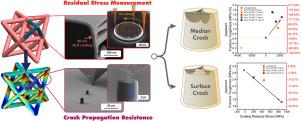Unlocking superior fracture resistance in micro-ceramics for architected meta-materials via ALD stress engineering
IF 9.3
1区 材料科学
Q1 MATERIALS SCIENCE, MULTIDISCIPLINARY
引用次数: 0
Abstract
Micro- and nano-architected metamaterials exhibit remarkable mechanical properties, particularly damage tolerance from the interplay between design and material properties, yet their fracture mechanisms remain poorly understood. Strategies to tailor toughness in response to the anisotropic stress distributions experienced are lacking. Here, we demonstrate a novel approach to enhance the fracture toughness of micro-trusses by up to 165% via interface engineering, leveraging the high surface-to-volume ratios in these materials. We investigate the role of residual stress induced by Atomic Layer Deposition (ALD) on fracture behavior using cohesive-zone finite element simulations and advanced experimental techniques, including pillar-splitting indentation cracking and advanced residual stress measurements. Experiments were conducted on fused silica micro-pillars (fabricated via deep reactive ion etching) and glassy carbon micro-pillars (produced via two-photon polymerization and pyrolysis), coated with ALD AlO or ZnO thin films. Our results reveal that median crack geometry combined with tensile residual stress in the coating enhances apparent toughness by inducing beneficial compressive stress in the substrate. Due to differences in crack morphology, AlO coatings increase the toughness of fused silica by 165% but reduce that of glassy carbon. This study establishes ALD-induced stress modulation as a powerful tool for optimizing fracture resistance in micro-architected ceramics.


通过ALD应力工程解锁微陶瓷结构超材料优越的抗断裂性能
微纳米结构的超材料表现出卓越的力学性能,特别是设计和材料性能之间相互作用的损伤容忍度,但它们的断裂机制仍然知之甚少。目前还缺乏针对所经历的各向异性应力分布调整韧性的策略。在这里,我们展示了一种新的方法,通过界面工程,利用这些材料的高表面体积比,将微桁架的断裂韧性提高了165%。我们研究了原子层沉积(ALD)引起的残余应力对断裂行为的作用,使用了黏结区有限元模拟和先进的实验技术,包括柱裂压痕开裂和先进的残余应力测量。实验采用深反应离子刻蚀法制备熔融石英微柱和双光子聚合热解法制备玻碳微柱,分别涂覆ALD Al22O33或ZnO薄膜。我们的研究结果表明,中间裂纹几何形状与涂层中的拉伸残余应力相结合,通过在基体中诱导有益的压应力来提高表观韧性。由于裂纹形态的差异,Al22O33涂层使熔融石英的韧性提高了165%,而使玻碳的韧性降低。本研究建立了ald诱导的应力调制作为优化微结构陶瓷抗断裂性能的有力工具。
本文章由计算机程序翻译,如有差异,请以英文原文为准。
求助全文
约1分钟内获得全文
求助全文
来源期刊

Acta Materialia
工程技术-材料科学:综合
CiteScore
16.10
自引率
8.50%
发文量
801
审稿时长
53 days
期刊介绍:
Acta Materialia serves as a platform for publishing full-length, original papers and commissioned overviews that contribute to a profound understanding of the correlation between the processing, structure, and properties of inorganic materials. The journal seeks papers with high impact potential or those that significantly propel the field forward. The scope includes the atomic and molecular arrangements, chemical and electronic structures, and microstructure of materials, focusing on their mechanical or functional behavior across all length scales, including nanostructures.
 求助内容:
求助内容: 应助结果提醒方式:
应助结果提醒方式:


